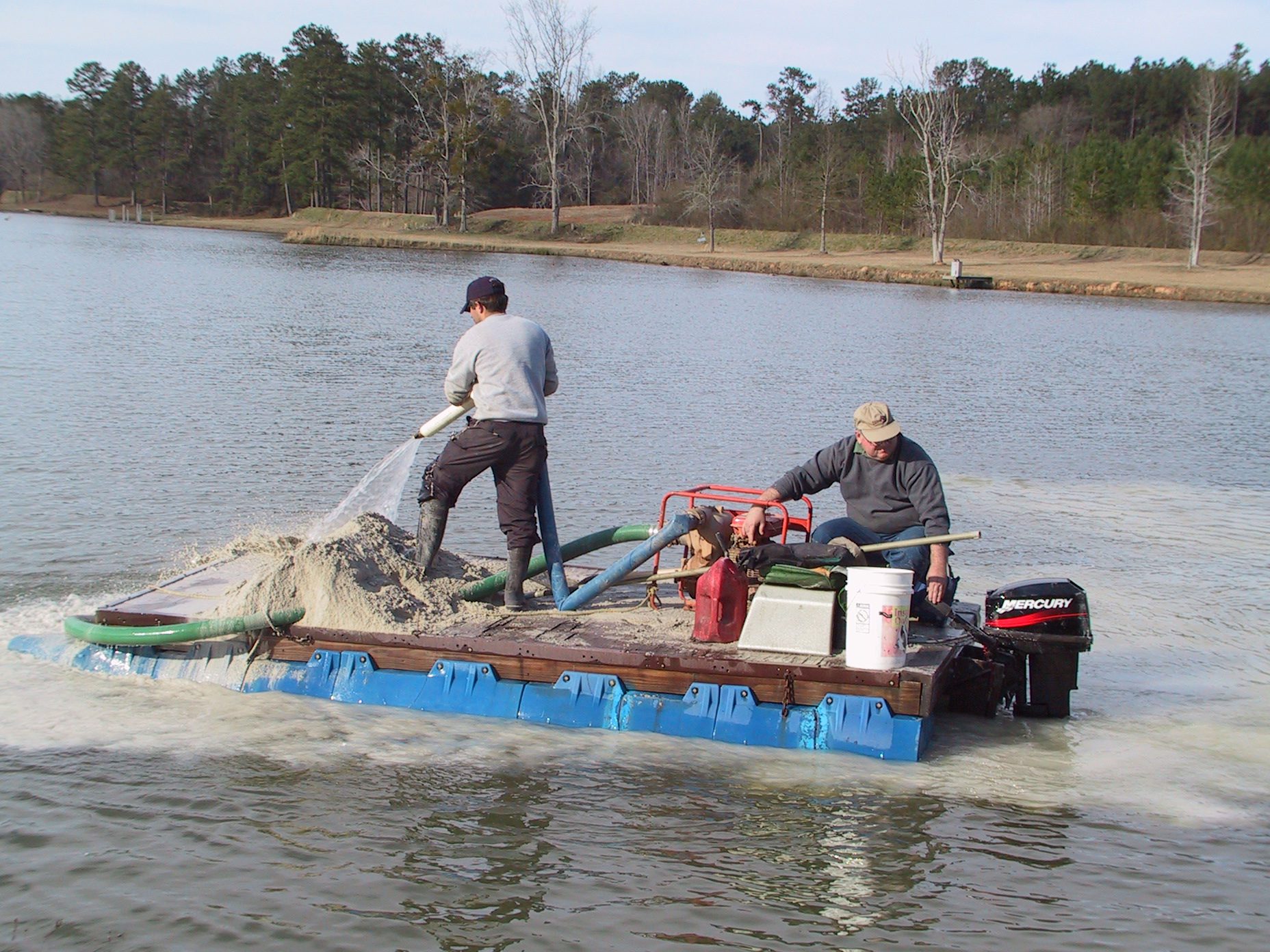Fish & Water

Even though ponds are never exactly alike, most can be managed for fishing. Following basic guidelines for good pond management will increase pond productivity and decrease problems.
Pond Construction and Watershed Management
Poorly constructed ponds are always difficult to manage. Water levels may fluctuate radically because of pond seepage, an inadequate watershed (the area that drains rainfall into the pond), or both of these conditions. Aquatic weeds may grow rapidly in shallow areas. Erosion, contamination, too much or too little water from the watershed can all make good management practically impossible.
Both Alabama Extension and the USDA Natural Resources Conservation Service (NRCS) can provide information and advice on pond construction. Refer to “Pond Building: A Guide to Planning, Constructing & Maintaining Recreational Ponds” (Extension publication ANR-1114). The NRCS has specific engineering publications that cover the design of dams, piping, etc., as well as other information related to local soil maps and processes to remain in compliance with pond construction regulations.
All ponds should be designed and maintained according to the following guidelines:
- Construct the dam with a compacted clay core.
- Be sure the soil lining the pond is a minimum of 20 to 30 percent clay.
- Match the appropriate pond size to the available watershed size.
- Construct banks to slope rapidly to a depth of at least 2 1⁄2 feet.
- Build drains and overflow pipes through the dam.
- Construct an emergency spillway for periods of heavy run-off.
- Limit livestock access to the pond.
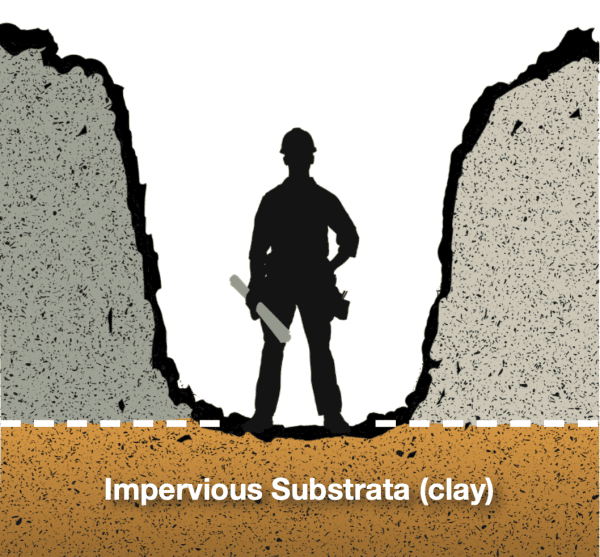
Cutting a trench for the clay core of the pond.
Pond leaks because of poor construction are common. To properly seal the bottom of the pond, the soil must contain at least 20 to 30 percent clay and be compacted in a layer 6 to 16 inches thick depending on water depth. Pond dams must be constructed with a compacted clay core that is trenched into impervious soil or a rock layer below the pond bottom.
Do not plant or allow trees to grow on the dam or on the spillway. Should the trees die or collapse during a storm, the roots can pull up, creating an opening in the surface that can cause the dam or spillway to fail. Rotting roots from dead trees and shrubs also can open a void in the dam, weakening the structure.
For established ponds with trees growing on the dam, cut any trees smaller than 8 inches in diameter at chest height. Keep larger trees healthy and do not cut unless the root ball can be safely removed. Keep emergency spillways clear of trees, shrubs, buildings, and equipment.
Drains allow water levels to be regulated for better control of weeds and fish populations, and for easy access to repair or renovate the pond. Drains with subsurface withdrawal, such as trash racks, help to preserve the productive water in the pond.
Alabama ponds generally need 4 to 30 acres of watershed per acre-foot of pond storage. For ponds built to the recommended average depth of 6 to 8 feet, about 15 acres of watershed per surface acre of pond meets is a good guideline to follow.
Soil types, slope, and vegetation covering the watershed will affect runoff. More area is generally needed if the watershed is wooded rather than mostly grassland or hard surfaces, such as roads, parking lots, or houses. If the watershed is too large, a diversion ditch around the pond may be needed to keep the pond from flushing too rapidly.
Aquatic weed growth occurs most often in shallow water. Pond banks should slope rapidly (2:1 or 3:1 ratio) to a depth of 2 1/2 feet or more. Aquatic plants do not easily establish themselves at this depth, especially if a good algae bloom is maintained.
Except for limited areas to provide access for watering, keep livestock away from the edge of the pond. Livestock erode pond banks, which creates shallow areas that can become infested with aquatic weeds. Cattle also cause damage to dams. Watering troughs built below the dam are the best way to move the cattle away from the pond edge. Otherwise, a fence around the pond with only a small access to the water is a good choice.
Fields next to ponds should have a sod border. Sod or grass strips 50 to 100 feet wide between the field and the pond reduce soil erosion, pesticide contamination, or excess nutrients from livestock or fertilizer applications.
Species Selection and Stocking
The choice of fish to stock depends on the pond goals and resources available. It is very difficult to manage a pond of less than 1⁄2 acre for bass and bluegill. If your pond is less than 1⁄2 acre, catfish is probably your best choice. Other combinations, such as hybrid bluegill and bass, or hybrid bluegill, bass, and catfish are possible stocking options.
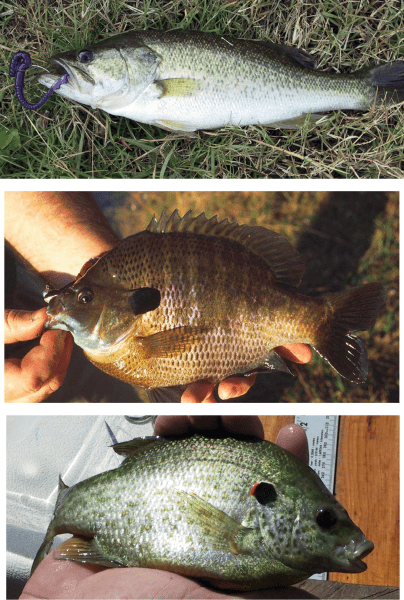
The combination of largemouth bass (top photo) and bluegill (middle photo) or largemouth bass, bluegill, and redear sunfish (bottom photo), is the most common stocking strategy used in the Southeast.
The combination of largemouth bass and bluegill (or largemouth bass, bluegill, and redear sunfish, also called “shellcrackers”) is the most common stocking strategy used in the Southeast. The combination generally works well in ponds larger than 1⁄2 acre and provides excellent fishing for all fish species indefinitely.
Bass, bream, catfish, and other fish for stocking new or renovated ponds may be obtained from private hatcheries and consultants in Alabama and surrounding areas. Private hatcheries will deliver directly to ponds and can provide fish at almost any time of the year (after February 1). Contact your county Extension agent or check the lists of producers provided at the Alabama Cooperative Extension System website for a list of private hatcheries that sell fish in Alabama. Fish can be purchased from traveling suppliers who bring in tank loads from other states. We recommend buying fish from local hatcheries for the following reasons:
- Fish from local sources are usually from strains of fish well adapted to the region.
- Locally produced fish are not stressed from being hauled, sometimes for days.
- It is far easier to follow up with local producers should any problems arise, such as poor survival after stocking.
- Buying locally reduces the potential of transporting invasive species or diseases across state lines.
Stocking of 2-to-3-inch bream is most often done in the fall or early winter. Bluegill will grow large enough to spawn the following spring. Bass are stocked in late May or June and grow rapidly, feeding on the bluegill fry produced by the fish stocked back in the winter and not the ones originally stocked. Bluegill will spawn two or three more times before fall, providing adequate forage for the bass. Bass growth should average 1⁄4 to 1⁄2 pound in the first year and can approach 2 pounds if forage is plentiful. Catfish can be stocked in fall or spring. If stocked together, always stock catfish as large as or larger than the bass.
Catfish usually cannot successfully reproduce in ponds with bass and bluegill populations. Catfish fry produced in the pond will be eaten by the bass and large bluegill. They will have to be restocked as they are fished out.
Species that should not be stocked into farm ponds or stocked only under certain conditions include crappie, hybrid bream, gizzard shad, flathead catfish, and common carp.
If the goals for a pond include catching crappie, then they can be stocked. However, both black and white crappie may pose management problems in small ponds in that they overpopulate and stunt at sizes too small to be harvested. Under these conditions, they compete with both bass and bream for food. Crappie generally cause fewer management problems in larger ponds (greater than 25 acres), but only after the largemouth bass initially stocked have spawned several times. Largemouth bass harvest must be carefully controlled to ensure enough bass in the pond to control crappie numbers.
Stocking gizzard and threadfin shad into established largemouth bass and bream populations reduces the number of fish that are available for harvest. Bluegill numbers and average sizes may decline while larger bass are usually present.
Pond owners wishing to manage for quality largemouth bass in ponds larger than about 8 acres may wish to stock threadfin shad. Stocking gizzard shad should only be considered in ponds managed for trophy bass. Cold winters can kill threadfin shad in ponds, especially in the more northern parts of Alabama. Reestablishing threadfin shad after a winter kill can be difficult due to enhanced bass populations.
Other species that should not be stocked into farm ponds are common carp and bullhead catfish. These can overpopulate rapidly, eat eggs of other fish, compete for food, and muddy the pond through their bottom feeding. Common carp and bullheads also can compete with bass and bream for food, reducing the growth and potential survival of the preferred fish. Flathead catfish are voracious predators. They can grow large enough to prey even on large bass.
Table 1. Recommended Stocking Rates for Largemouth Bass, Bream, and Catfish in New or Fully Renovated Ponds
| Species | Stocking Rate per Acre for Fertile Ponds | Stocking Rate per Acre for Unfertile Ponds |
|---|---|---|
| Largemouth bass | 75–100 | 50 |
| Bream (either all bluegill or 20% redear sunfish and 80% bluegill) | 1,000 | 500 |
| Catfish | 50–100 | 25 |
Removal of Unwanted and Overpopulated Species of Fish
Fish populations in poorly managed ponds usually become out of balance. Alabama ponds can become crowded with stunted bass or bream populations or become populated with species such as common carp, crappie, green sunfish, bullhead catfish, or other unwanted species. The best management option in these situations may be to eliminate all fish in the pond and start over.
Removing or killing the fish population usually is much easier and less expensive if the pond can be drained dry or partially drained and the fish concentrated. Fish will survive in very small pools or puddles away from the main body of water. To remove all fish, all puddles must be treated, even those in the watershed, no matter how small, with an approved toxicant.
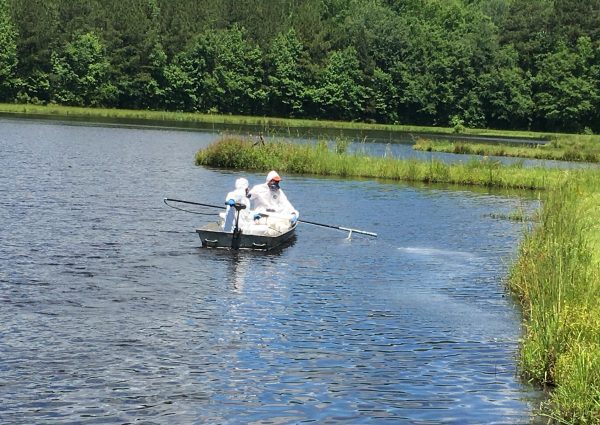
Application of rotenone to kill unwanted fish populations. Pond was partially drained to concentrate fish and reduce risk of runoff.
Rotenone is a registered aquatic chemical that is used to kill fish. In Alabama, rotenone for pond renovation can be purchased from most farm supply or feed-and-seed stores by anyone with a pesticide applicator permit. Rotenone is classified as a RESTRICTED USE pesticide.
Rotenone comes in liquid or powder formulations at a concentration of 5 percent active ingredient. Apply rotenone at a rate of 2 to 3 ppm (2.7 pound/acre-foot of granular = 1 ppm), 5.4 to 8.1 pounds per acre-foot of actual product.
The volume of water in the pond (in acre-feet), or that which remains after draw-down, must be estimated so that this concentration of rotenone can be calculated. One gallon of the liquid rotenone formulation (5 percent) is sufficient to treat approximately 3 acre-feet of water at 1 ppm, or 1 acre-foot at 3 ppm.
Acre-feet in a particular pond can be calculated by multiplying the surface area in acres times the average depth in feet. For example, a 2-acre pond with an average depth of 6 feet would have 12 acre-feet and require 4 gallons of the liquid 5 percent formulation to treat at a concentration of 1 ppm, 8 gallons for 2 ppm, etc.
Mix powdered rotenone with water (about 2 gallons per pound of powder) into a soupy consistency. Dilute liquid rotenone with water at a rate of about 10 gallons of water to 1 gallon of rotenone.
Apply rotenone evenly over the pond using buckets, sprayers, or pumps. If the pond is greater than 4 feet deep, use a hose to inject rotenone into deep sections of the pond.
Rotenone applied properly and at recommended rates will not harm most livestock, even if they drink the water. Pigs, however, might be affected by the rotenone formulation, and ducks and geese may suffer if they gorge themselves on dead or dying fish.
No water containing active rotenone should be allowed to run off into receiving streams or reservoirs where it could damage those systems. Again, lowering the water level in the pond prior to application will help prevent rotenone contamination downstream.
Rotenone is usually applied in the fall when the water temperature is between 65 and 75 degrees Fahrenheit. Rotenone will dissipate within 3 to 10 days, depending on weather conditions. It is generally safe to restock 2 to 3 weeks after applying rotenone. To check if rotenone is still present at toxic levels, place a few small bream in a minnow bucket and float it in the pond. If the fish are still alive after 24 hours it is safe to restock. In very cold weather, rotenone may be toxic for as long as a month.
Contact a district fisheries biologist or county Extension agent for additional information on purchasing and applying rotenone.
Maintaining Fertility
Maintaining consistent fertility in a pond is important to creating a relatively stable, productive pond. Maintaining fertility should not be confused with fertilization. Not all ponds should be fertilized.
Fertilization may not help in meeting pond goals and can actually cause problems if not done correctly. Maintaining the alkalinity and hardness of the water, usually by applying agricultural lime, is important whether or not the pond is fertilized.
Alkalinity, the ability of the water to resist changes in pH, should be above 20 ppm to keep the system stable. Check alkalinity first. If it is below 20 ppm, add agricultural limestone to neutralize acidity in the soil. Hydrated or slaked lime can be used as a temporary way to increase alkalinity, but it must be used carefully, usually at less than 100 pounds per acre. Hydrated lime can cause a rapid pH change that may kill fish.
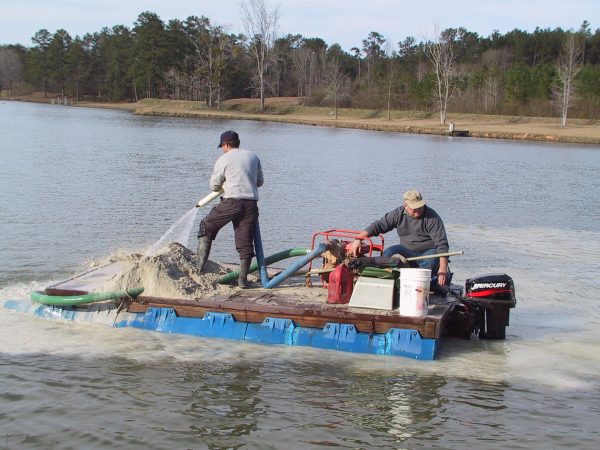
Lime application using a pontoon barge and water pump to evenly distribute the lime.
The amount of lime necessary depends on the characteristics of the soil in the pond bottom. A soil sample can be analyzed to determine the amount of lime needed. While water sample analysis is a great way to monitor the pond and determine if lime might be needed, soil samples provide a more accurate estimate of the amount of lime needed.
Take soil samples from many places in the pond. Combine these samples and spread them out to dry. After samples are dry, mix them together thoroughly and take one sample for analysis. Send to the Auburn University Soil Testing Lab in a soil test box (available from your county Extension agent). Mark the sample “fish pond” so that the proper tests can be run. The analysis will recommend the proper liming rate.
Ideally, lime should be applied evenly over the entire pond so that it can react with the bottom mud. Do this in winter or early spring before fertilization occurs. Liming in the warmer months could cause oxygen depletion and fish kill.
If the pond is thoroughly dry, a spreader truck can be used to distribute the lime over the entire bottom. For full ponds larger than about 3 acres, lime will have to be washed off of a barge to cover the bottom. While less ideal, smaller ponds can be limed from the edge using the power spreader, provided there is good access to the edge for a large truck. The truck can be backed up to several spots around the pond and the power spreader used to sling the lime out over the surface.
Several pond management consultants in Alabama will lime ponds. County Extension offices may have contacts for local consultants who provide this service or a list of pond consultants can be found online at www.aces.edu.
Lime slowly dissolves into pond water and is washed out with overflow water. This means that ponds may need to be limed every 2 to 4 years. Many pond managers find it practical to increase the liming rate by one and a half or two times the amount recommended. This increases the length of time between lime applications. Adding more than the recommended lime (agricultural lime only) will not harm the pond. A typical liming rate in Alabama is around 2 tons per surface acre of pond. Remember, if a pond needs lime it will not respond well to fertilizer and is more likely to have low oxygen events due to algal bloom die-off.
Fertilizing ponds will increase fish production two- to threefold. Infertile ponds seldom produce more than 100 pounds of fish per acre. Well-managed fertile ponds can maintain 300 to 400 pounds of fish per acre.
If the pond is naturally fertile and is not going to receive much fishing pressure, it may not require fertilizer. If the pond receives only minor fishing (or harvest) pressure, do not fertilize. Fertilizing a pond where the largemouth bass are not adequately harvested will result in a pond with stunted bass in poor physical condition.
Once fertilization is started it should be continued consistently. If fertilization is stopped, the fish will stunt because of the reduced food supply and become more susceptible to disease. Inconsistent fertilization also may stimulate weed growth.
Not all fertilizers work well in ponds. Phosphorus is the nutrient most needed in ponds. Given time, the phosphorus will be absorbed and trapped in the mud of the pond through chemical processes. Once trapped, it is not available to planktonic algae but can promote the growth of weeds and filamentous algae. While nitrogen is not usually the most limiting nutrient for ponds, it is important to apply fertilizer with both phosphorus and nitrogen. Fertilizer with only phosphorus tends to favor cyanobacteria (bluegreen algae), which can be toxic and create unsightly surface scums.
Fertilizers are labeled with N-P-K ratios or percentages of nitrogen (N), phosphorus (P2O5), and potassium (K2O). Liquid fertilizers can be easier to apply and may produce blooms quicker than granular fertilizers. Table 2 lists recommended rates for commonly available fertilizers.
Table 2. Recommended Fertilization Rates for Ponds
| Fertilizer Formulation | ||
|---|---|---|
| Granular | Pounds/acre/application | |
| 20-20-5 | 40 | |
| Liquid | Gallons/acre/application | |
| 13-38-0 | 1 | |
| 10-34-0 | 1 | |
| Soluble powder | Pounds/acre/application | |
| 10-54-5 | 4 - 6 | |
| 10-48-5 | 4 - 6 | |
A simple method of knowing when to fertilize is based on water clarity. The depth that light can penetrate into the pond is a measure of the algae density or bloom. Light penetration can be measured using a Secchi disc. A Secchi disc can be made from an 8-inch-diameter disc of plywood, metal, or plastic. Mark the disc into quarters and paint the two opposite quarters white and black, respectively. Attach the disc to a yardstick or to a pole marked at 12, 18, and 24 inches from the disc.
The optimal algae bloom is one that allows light to penetrate to a depth between 18 and 24 inches. Submerge the Secchi disc into the pond until it just disappears; note that depth. Follow table 3 as a guide to fertilization. If the Secchi disc disappears between 18 and 24 inches, there is no need to fertilize. It is time to fertilize again if the disc visibility is increasing rapidly toward 24 inches or is visible past 24 inches. If the disc disappears between 12 and 18 inches, the bloom is too dense. In this case, do not fertilize and watch the pond closely. If the disc disappears in less than 12 inches, the bloom is very dense, and severe oxygen depletion could occur. Do not consider low Secchi readings that are the result of muddiness rather than algae.
Table 3. Recommendations for Fertilization and Management Based on Secchi Disc Readings
| Secchi Disc Reading | Recommended Management |
|---|---|
| Greater than 24 inches | Fertilize |
| 18–24 inches | Good bloom: do nothing |
| 12–18 inches | Dense bloom: watch closely |
| 12 inches or less | Bloom too dense: determine source of excess nutrients and be prepared to aerate at night |
| 6 inches or less | Oxygen depletion imminent |
A Secchi disc reading of 12 inches or less means the pond is too nutrient rich. At that point, the sources of excess nutrients must be found and controlled. Has too much fertilizer been added? Are fish being fed too heavily? Try to discover the source of the problem. Dense blooms can consume most of the pond’s oxygen at night. Be prepared to aerate at night if the visibility is low and there are consecutive days of cloudy weather.
Granular or liquid fertilizers can be used in ponds. Granular fertilizers must not be broadcast into the pond. Granules will sink to the bottom, and the phosphate will be absorbed directly into the mud and be lost or, worse, may stimulate weeds and filamentous algae. Place granules on a platform that is submerged about 12 inches underwater. One platform usually is needed for every 25 surface acres of pond.
Place the platform in an area of the pond that has wave action. Granules placed on the platform dissolve slowly, spread throughout the pond by water currents, and stimulate a bloom.
Liquid fertilizers are dense and must be diluted with water before applying, or they will sink to the bottom and be absorbed into the mud. Mix several parts water to fertilizer and spray, splash, or mix into the pond; for example, dribble it out in the prop wash of a boat. When splashing the diluted fertilizer from shore, put it out in multiple spots around the pond in areas deeper than 3 to 4 feet.
Soluble powder fertilizers are the easiest of the forms to apply. For this type make sure there are no lumps in the powder and sling it out across the surface in water deeper than 3 to 4 feet. The powder also can be poured onto a platform like the granular forms or dissolved and put out like the liquid.
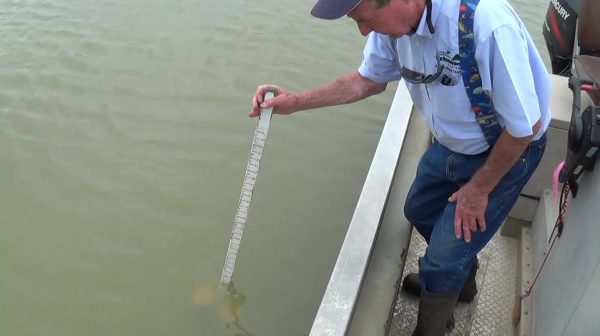
Lowering a Secchi disc to measure water transparency
While the cost per application of soluble fertilizer is typically higher than liquid, the ease of application has made this form preferred by many pond owners. The reduced labor cost also makes this approach the choice of many pond management consultants.
Fertilization should begin in late February or early March, depending on when the water temperature reaches about 60 degrees Fahrenheit.
The first fertilizer application does not always stimulate a bloom. Continue to fertilize at 2-to-3-week intervals until the pond blooms green.
Some ponds may not produce a bloom with standard high phosphorus fertilizer. If the pond does not turn green with a plankton bloom after three or four applications of high-phosphorus fertilizer and does not have excess flushing or muddiness, it may need nitrogen to stimulate the bloom. Adding 10 pounds of urea-based fertilizer (for example 46-0-0 or 35-0-0) per acre after typical pond fertilization is often effective. Unlike phosphorus-containing fertilizer, urea granules can be scattered in water less than 8 feet in depth.
Once a bloom is established, fertilize as necessary to maintain it. Use the Secchi disc guide in table 3 to help make management decisions.
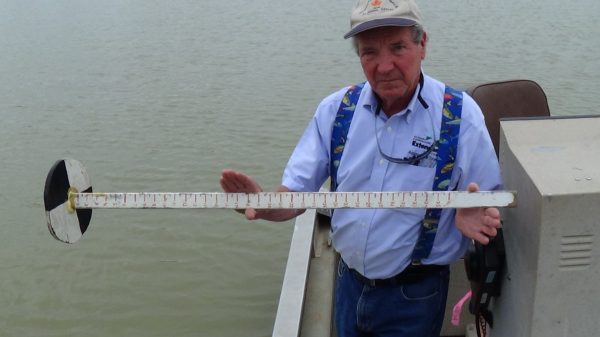
A Secchi disc can be used to determine when to fertilize.
Continue fertilizing until late October. Some pond managers continue to fertilize through the winter. Although research suggests that winter fertilization does not increase the growth of fish, many managers feel that maintaining the bloom provides some extra food and reduces filamentous algae problems.
One important word of caution: Do not fertilize ponds that are infested with aquatic weeds. The fertilizer will only stimulate growth of the weeds. Control weeds before fertilizing. Establishing a good fertilization program before weeds appear is one of the best methods of weed prevention.
Ponds that are flushed by large volumes of water lose fertilizer more rapidly and may not sustain a bloom. In this case, fertilization is usually ineffective and should be discontinued unless the excess water can be diverted. Many ponds flush repeatedly in winter and early spring but respond well to fertilization in late spring, summer, and fall.
Muddy ponds (12 inches or less visibility) usually do not respond to fertilization. Several methods have been used to clear muddy ponds. In most cases, the addition of lime to reduce acidity will settle a muddy pond. If liming does not settle the mud, contact your county Extension agent for advice.
Harvesting and Record Keeping
Ponds should not be fished for 1 year after bass are stocked. This allows the bass time to grow and reproduce.
Once fishing begins, harvest the bass and bream to maintain growth and meet goals, whether that is a balanced pond with good-quality bass and bream, trophy bass, or trophy bream. Table 4 provides the harvest rates needed to help meet those goals.
Table 4. Recommended Harvest Rates (Pounds/Acre/Year) and Enhancements for Alabama Largemouth Bass/Bream Ponds Based on Management Goals
Balanced pond = good-quality fishing for bass and bream
| Fertilized | Unfertile | Other Enhancements | |
|---|---|---|---|
| Bass | 20–25 | 10 | No enhancements required. Adding fish attractors and limited pellet feeding can be done to increase catch rate. In larger ponds, threadfin shad can be stocked as a moderate bass enhancement. |
| Bream | Up to 200 | Up to 100 | |
| Trophy Bass | |||
| Bass | 30 | 15 | Typically only recommended for fertile ponds or ponds greater than 30 acres in size. Stock temporary forage for bass, such as minnows and crawfish. For longer-term greater effect, stock threadfin or gizzard shad |
| Bream | Up to 200 | up to 100 | |
| Trophy Bream | |||
| Bass | 10 every 4–5 yr harvest 20–25 lb for 1 year | 5 | Typically only recommended for fertile ponds. Pelleted feed at no more than |
| Bream | 50 | 25 |
Bass harvest must be carefully controlled as well as encouraged to have quality fishing. After initial stocking, bass often are easy to catch. It is possible to catch more than 70 percent of the bass population in a few days of intensive angling, especially in small ponds.
Bluegill will quickly overpopulate and stunt the pond if bass are overharvested. If this happens, regaining a balanced population will be difficult, and the pond may require renovation for a fresh start.
Begin harvesting about 1 year after stocking. If the bass are stocked in June, harvest can begin the following June.
During the first 6 months of harvest, take no more than 10 pounds of bass per acre in a fertile pond and 5 pounds per acre in an infertile pond. As a general rule, in the following years, a fertile pond requires the harvesting of about 25 pounds of bass per acre per year. If the pond is infertile, only 10 pounds per acre per year should be harvested to manage for balanced conditions. In general, bass 14 inches in length and smaller should be targeted but some larger fish can also be harvested.
In ponds managed for trophy bass, remove 30 to 35 pounds of bass per acre each year. The majority of the bass harvested should be 14 inches and under in length.
If the goal is trophy bream, harvest 10 pounds per acre of bass primarily 14 inches or longer. The more numerous bass eat more bream, and bream that survive grow faster because there is more food or less competition per fish.
Both trophy bass and trophy bream ponds should be fertile. Other enhancements, such as stocking alternative forage for bass or adding pelleted feeds for bream, can be part of trophy management.
A problem that can occur is the underharvest of bass that causes a bass-crowded condition. In this situation, too many bass are present and few bream reach maturity. The few bream that do escape grow rapidly to a large size. The bass do not have enough food (small bream), become stunted, and are in poor physical condition. Many times this condition can be corrected by heavily harvesting the bass, although it may take a couple of years to fully correct the problem.
Over- or underharvest of bream appears to have little effect on the population balance in the pond. Heavy fishing, however, will reduce the average size of bream harvested. Research has never shown that heavy angling is effective at countering bream overpopulation; however, larger bream result when bass harvest is restricted.
Quality bream fishing can be managed by regulating the harvest of bass. If fewer than 10 pounds of bass are harvested per acre per year, the average size of bream will increase. The more numerous bass eat more bream, and bream that survive grow faster because there is more food or less competition per fish. If no bass are harvested, however, a bass-crowded condition will occur.
Catfish reach eating size within 6 to 12 months after stocking. Catfish stocked with bass and bluegill are generally unable to reproduce successfully because their fry are eaten. Therefore, catfish must be restocked periodically. An 8-inch or larger catfish fingerling should be stocked into ponds that have adult bass.
Keep records of numbers and pounds of fish harvested to determine if the proper amount of bass has been taken out during a year. Pond balance can be evaluated from catch records plus seine data or electrofishing catches.
Catch Record
All harvest of fish should be recorded; provide number and pounds of fish taken out of the pond.
| Date | Number Fishing | Initials | Fish Harvested Bass (lbs) | Fish Harvested Bass (number) | Fish Harvested Bream (lbs) | Fish Harvested Bream (number) | Fish Harvested Catfish (lbs) | Fish Harvested Catfish (number) | Fish Harvested Other (lbs) | Fish Harvested Other (number) |
|---|---|---|---|---|---|---|---|---|---|---|
Evaluation of Pond Balance
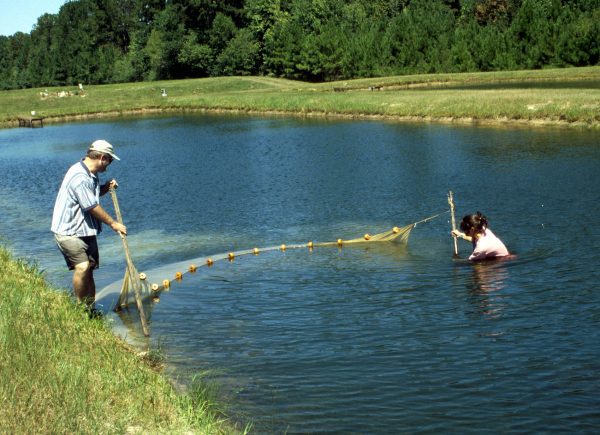
Seining a pond in early June to check pond balance
Check ponds for balance every 1 to 2 years if the fishing quality is perceived to be unsatisfactory. The district fisheries biologist with the Alabama Department of Conservation and Natural Resources Division of Wildlife and Freshwater Fisheries may be able to assist in checking pond balance. Call the district office well in advance to schedule a visit. Private fisheries consultants also are available to evaluate pond balance. A list of consultants in Alabama is available on the Alabama Extension website at www.aces.edu.
Pond balance can be checked by using a 15-foot minnow seine (1⁄4-inch mesh or smaller). The best time to check is early June. Seine several (a minimum of three) shallow areas of the pond that are clear of brush.
Allow the seine to arch or cup slightly as it is pulled so that fish cannot easily swim around it. Samples from seining provide information on reproductive success and the presence of unwanted species.
Record the number of bluegill captured in groups: less than 3 inches, 3 to 5 inches, and greater than 5 inches. Also look at bass condition (plumpness) and for unwanted species. Refer to table 5 to analyze pond balance from seine and catch data.
Professional pond consultants can use electrofishing to assess the status of fish populations in ponds. Electrofishing is an excellent way to collect adult fish, which biologists can use to determine the size structure of the populations and the physical condition or fatness of the fish.
Table 5. Evaluation of Pond Balance Using 15-Foot Seine and Catch Data
| Type of Fish Caught | Concluson | Recommendation |
|---|---|---|
| Seine data—small and intermediate bluegill and young-of-year largemouth bass | Fish populations in balance | No additional management necessary |
Angler catch data—bass and bluegill of various sizes | Fish populations in balance | No additional management necessary |
Seine data—many intermediate bluegill and few or no young-of-year bass | Bluegill crowded | Remove intermediate bluegill by shoreline; rotenone in fall or stock 25–50 advanced fingerling (6′′–8′′) or 20–30 adult bass (12′′ or larger) per acre |
Angler catch data—few harvestable size bluegill; few large bass | Bluegill crowded | Remove intermediate bluegill by shoreline; rotenone in fall or stock 25–50 advanced fingerling (6′′–8′′) or 20–30 adult bass (12′′ or larger) per acre |
Seine data—few intermediate bluegill; many recently hatched bluegill | Bass crowded | Remove 50–75 (35 lb) bass per acre |
Angler catch data—bass numerous but small and thin; bluegill few but large and robust | Bass crowded | Stock 100–200, 4′′–5′′ bluegill per acre |
Seine data—unwanted species, no recent bluegill hatch, few intermediate bluegill | Fish populations dominated by unwanted species | Rotenone and start over |
Angler catch data—few harvestable-size bluegill and unwanted species (crappie, bullhead, green sunfish, shiners, etc.) | Fish populations dominated by unwanted species | Rotenone and start over |
Angler catch poor for bass and bream; body condition poor for all species | Water quality poor; excessive weeds | Maintain consistent fertility; control weeds |
For more information on determining fish condition, refer to “Relative Weight: An Easy-to-Measure Index of Fish Condition” (Extension publication ANR-1193).
If fishing is adequate and seine data show both young bass and recently hatched bluegill fry, the pond is probably in balance. If no young bass and bluegill fry are found, but many 3-to-5-inch intermediate-size bluegill are caught, the pond is probably out of balance and bluegill crowded. If there are undesirable species, it is time to poison and restock. Tadpoles in large numbers indicate that few bass are present.
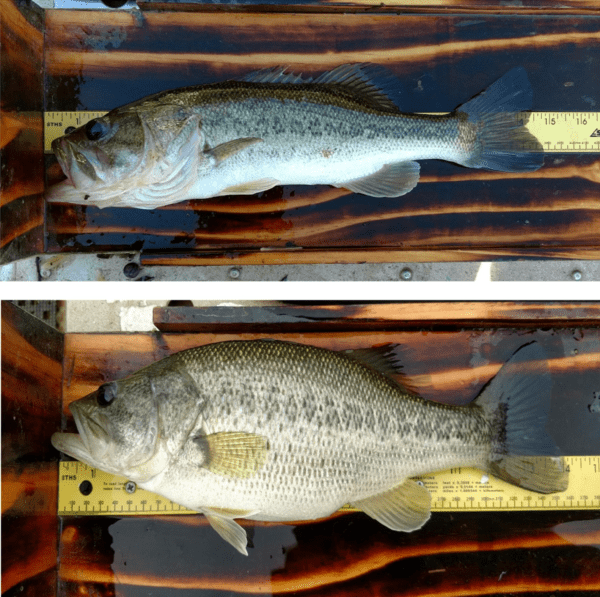
Plump bass (bottom picture) is in good condition, while skinny bass (top picture) is in poor condition and suggests “bass-crowded” pond. (Photo credit: Taylor Beaman, Alabama Department of Conservation and Natural Resources)
If an overpopulation of bream is the problem, trying to fish, trap, or seine enough bream to restore balance will not be practical or possible. If the problem has occurred relatively recently and bass reproduction has only been compromised for a year or two, reducing bass harvest and stocking twenty-five to fifty 6-to-8-inch advanced fingerling bass or twenty to thirty adult bass (12 inches or larger) per acre in the fall may correct the problem.
More persistent, slow-growing, and stunted bream populations can be corrected by applying rotenone along the margins of the pond in the early fall to achieve a partial kill. Apply rotenone when the water temperature drops below 80 degrees Fahrenheit so that surviving bream will not reproduce until the following spring. Water temperatures should not be below 70 degrees, however, as the rotenone will remain toxic for too long.
In this procedure, rotenone is applied to the margin of the pond at a distance of approximately 20 to 30 feet from the shore, but not in water deeper than 5 feet. Rotenone usually is applied at midday when the sun is shining and the drift is toward the shore.
The rotenone formulation can be diluted and poured into the prop wash of an outboard motor. Be careful to avoid skin contact. The objective is to remove approximately half the bluegills in the pond. Following a partial rotenone treatment, stock the pond with 6-to-8-inch largemouth bass. For fertile ponds larger than 10 acres, stock 50 per acre; in smaller fertile ponds stock 70 per acre. Stock half these rates in infertile ponds.
A partial application of rotenone can be a tricky procedure. Pond owners may want to contact a state fisheries biologist, fisheries specialist, or fisheries consultant for assistance.
For bass-crowded ponds, increasing bass harvest is usually the first recommendation. Harvesting 25 to 30 pounds of bass per acre each year can often correct the problem; however, it may take a few years of extra harvest to fully bring the pond into balance.
Stocking intermediate-size bream (3 to 5 inches in length) at 100 to 200 per acre can speed up the process. Conducting a late spring marginal rotenone application using the same process as used to correct bluegill crowding has been shown to reduce largemouth bass reproduction by killing the juveniles. This approach has shown promise but would require annual applications, likely for three years, combined with appropriate harvest to be effective in reducing largemouth bass abundance.
This type of rotenone application must be done carefully. Pond owners should seek help and guidance from professional fisheries biologists, specialists, or pond management consultants when conducting a rotenone application.
If ponds have been either severely bass or bluegill crowded for a few years, it may be more efficient to completely renovate the pond, removing all fish (draining and rotenone application), and restocking. Ponds that might best be managed with a complete renovation usually have no reproduction in either or both bass and bream and poor body condition in the crowded population.
Weed Control
Aquatic weed control is a common problem in ponds. Some aquatic vegetation might be good for fish production in ponds. Rooted aquatic vegetation provides habitat for some small aquatic animals, which adds to the food chain. Vegetation also provides small fish with places to hide from larger predators. The problem with weeds is uncontrolled growth. If too many weeds become established in the pond, too many small fish survive and overpopulate, and removal of nutrients by the weeds reduces algae production. Also, predators become thin because they are not able to prey on the forage species.
Aquatic weeds can be controlled by manual, chemical, and biological means. Manual control (i.e., cutting or digging them out) of species such as cattails is practical when they first start to colonize a pond. Woody vegetation along the dam also can be controlled manually. Barrier methods can be used to prevent the growth of weeds. Barriers are usually geotextiles covered with a layer of gravel to hold them in place and protect the cloth from sunlight and physical damage.
Chemical control with herbicides is possible, but few herbicides are approved for aquatic use, and the type of aquatic vegetation must be accurately identified before it is treated. Herbicides, particularly copper-based algicides, can kill planktonic algae, leading to oxygen depletion. Oxygen depletion after herbicide treatment is particularly common in hot weather or if the pond is heavily infested with weeds. Decomposition of the killed weeds can deplete the oxygen from the system.
Check with a fisheries biologist or your county Extension agent for plant identification and current herbicide recommendations. When using chemical pesticides, protect yourself and others by strictly following all label directions.
The simplest and often least expensive long-term aquatic weed control method is to stock grass carp. Grass carp, or white amur, is an Asian carp brought to this country for aquatic weed control.
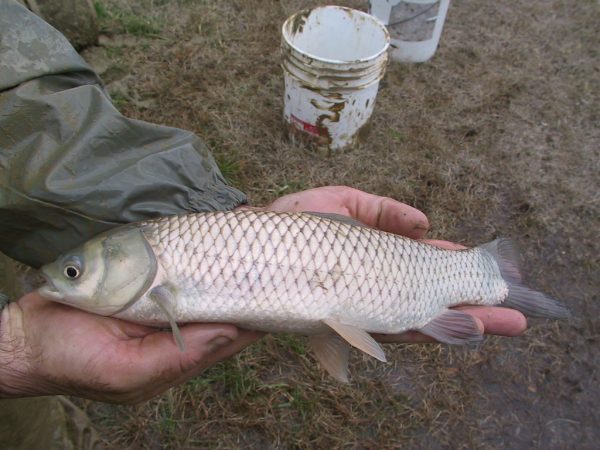
Grass carp grow rapidly and will control most underwater weeds if stocked at recommended rates.
Grass carp consume vegetation almost exclusively after they reach 10 inches in length. They will not reproduce in the pond, will not muddy the pond like common carp, will not disturb the nests of other fish, and can consume two to three times their body weight in weeds each week during warm weather.
Just like with herbicide application, it is important to make sure that the weeds in question are ones that grass carp control. Grass carp typically eat flexible plants that grow beneath the water, such as hydrilla or southern naiad. Stiffer plants or plants that grow out of the water, such as cattails or alligator weed, may not be controlled by grass carp.
Grass carp are attracted to running water and will leave the pond over the emergency spillway during heavy rains. Not only is it important to keep grass carp in the pond for weed control, but it is important to limit their escape into our rivers and public reservoirs. The escape of grass carp from a pond can be limited by building a correctly designed barrier across the spillway.
The number of grass carp to stock depends on the type of weed, condition of the pond, and magnitude of the weed problem. Table 6 gives recommended stocking rates.
Table 6. Recommended Stocking Rates for Grass Carp
| Weed Evaluation | Number of Fish to Stock |
|---|---|
| New pond or very slight weed problem | 3–5 per surface acre |
| Moderate weed problem (10%–20% coverage) | 10–15 per acre of weeds |
| Severe weed problem | 15–20 or more per acre of weeds |
If stocking grass carp into a pond with mature bass, stock an 8-inch or longer fish. Grass carp are less effective at controlling weeds after they reach 20 to 30 pounds in size (usually 5 to 7 years after stocking). As vegetation starts to reappear, restock the pond with new grass carp. While it is not critical to remove large grass carp when restocking with smaller fish, they can be removed by bowfishing, spearing, or angling using a light wire hook and a bit of bread for bait. Grass carp are excellent table fare.
In the case of a severe weed problem, it may be most effective to treat the pond with a herbicide first and then to stock 10 to 15 grass carp per acre of weeds to maintain weed control.
More information about grass carp, including where to purchase them, can be found on the Extension website at www.aces.edu. See “Using Grass Carp to Control Weeds in Alabama Ponds” (Extension publication ANR-0452). Extension Agents and Specialists as well as publications at the Alabama Cooperative Extension System website can provide further information on the identification and control of aquatic weeds.
Alternative Stocking Strategies
Ponds of less than 1⁄2 acre are very difficult to manage for bass and bream. Probably the best management strategy for this size pond is to stock it with channel catfish or hybrid blue X channel catfish only. Catfish are splendid fighters and are great to eat.
The best way to calculate how many catfish to stock is to consider how many are needed for harvest. It takes them from 1 to 2 years to grow to eating size, depending on how often and how much they are fed.
In ponds that will not be fertilized, stock about 100 catfish per acre. In fertilized ponds without feeding, stock 200 to 300 per acre. In ponds that include feeding, 300 to 2,000 per acre may be stocked, although stocking more than about 400 per acre will likely require aeration given the amount of feed needed to produce good growth rates.
At higher densities, feed catfish April through October and at reduced rates during the winter. Feed no more than 6 days per week and do not feed more than 20 pounds per acre per day.
Table 7 assumes that the average weight of the fish is about 1 pound. In this kind of management system, fish removed by fishing can be replaced by restocking 5-to- 6-inch catfish fingerlings in the early spring.
Table 7. Approximate Feeding Rates April to November for Catfish-Only Ponds on 6-Day-Per-Week Feeding Schedule
| Month | Water Temperature | Approximate % Body Weight/Day | Weight of Feed per Acre | ||||
|---|---|---|---|---|---|---|---|
| Lb/day | °F | (300) | (800) | 300 fish/acre lb/day | 800 fish/acre lb/day | ||
| April | 60–70 | 2.0 | 2.0 | 6.0 | 16.0 | ||
| May | 70–80 | 2.3 | 2.3 | 6.9 | 18.4 | ||
| June | 80–85 | 2.5 | 2.4 | 7.5 | 19.2 | ||
| July | 83–86 | 2.8 | 2.5 | 8.4 | 20.0 | ||
| August | 83–86 | 3.0 | 2.5 | 9.0 | 20.0 | ||
| September | 75–85 | 2.5 | 2.4 | 7.5 | 19.2 | ||
| October | 65–75 | 2.0 | 2.0 | 6.0 | 16.0 | ||
In many cases catfish reproduce too much if stocked alone in ponds. Bass can be stocked at about 20 to 30 per acre with catfish to limit reproduction. Another way to limit overpopulation is to stop reproduction. Since catfish are cavity spawners, reproduction can be limited in ponds by (1) removing all stumps, rock piles, etc.; (2) not allowing muskrats or beavers to colonize (catfish will spawn in the burrows); and (3) not providing any type of container that could be used for spawning (for example, tires or barrels).
Other fish that can be stocked in small ponds include blue X channel catfish hybrids, hybrid bluegill, threadfin shad, golden shiners, fathead minnows, and rainbow trout. Before stocking these species, talk with a fisheries biologist.
Blue catfish and the blue catfish X channel catfish hybrid can be stocked instead of channel catfish. They grow larger and are better predators than channel catfish, but they will compete with bass. The hybrid catfish is an excellent fish to angle for; it often takes artificial lures like a bass. These hybrids are the preferred type of catfish for catfish-only ponds.
Hybrid bluegill have a large mouth and train readily to commercial fish feed. They grow rapidly if fed commercial fish feeds and are excellent for angling. They are not sterile as is sometimes claimed. Most are males, but if females are present they will reproduce. Offspring produced are undesirable; therefore, hybrid bluegill should be stocked with 20 to 30 bass per acre to prey on any young produced. Every 3 to 4 years the pond will need to be drained and restocked.
Golden shiners, fathead minnows, and threadfin shad can be stocked for forage. Many states promote the use of golden shiners or threadfin shad as bass forage. Both species can reproduce rapidly in ponds and provide excellent forage for bass.
Golden shiners will compete with young bream for food, will eat bass and bream eggs, and can overpopulate mostly in ponds with weed problems. Threadfin shad are excellent bass forage but may not survive winter temperatures in ponds in central to northern parts of Alabama.
Fathead minnows are slow swimmers and do not grow large as adults. If ponds are stocked with bass, fatheads are quickly eliminated. In small ponds stocked with only channel catfish and not fed regularly, fathead minnows can provide excellent forage. Stock about 500 fathead minnows per acre.
Hybrid striped bass (Morone chrysops × saxatilis) can be an excellent addition to larger ponds (greater than 10 acres) that have established threadfin or gizzard shad populations. Hybrid striped bass tend to be aggressive, fun fish to catch and are excellent table fare.
Up to 10 hybrid striped bass per acre can be stocked. At the higher range of this stocking rate, they will compete with and perhaps reduce the growth rate of largemouth bass in the pond. Because of their aggressive nature, their numbers can usually be reduced if necessary through targeted angling.
Hybrid striped bass will not reproduce in the pond and must be maintained by periodic stocking. Some attempts have been made to use hybrid striped bass in combination with crappie and threadfin shad or minnows to create a fishery focused more on crappie than largemouth bass and bream. Currently, we cannot give specific recommendations on the proper stocking and management of this combination.
Rainbow trout survive in Alabama ponds only during the winter. They can be stocked when the water temperature is near 65 degrees Fahrenheit, usually by early November. Stocked as 7-to-9-inch fingerlings, they grow rapidly, feeding on insect larvae and small bream. Rainbows also will eat commercial fish feeds and can grow to 1 pound by April. Rainbows die as water temperatures reach 70 to 72 degrees in early April. Trout angling can be outstanding when the water temperature is above 50 degrees in March and early April.
Fish Kills in Ponds
The sudden death of a significant number of fish in a pond can be caused by the loss of dissolved oxygen, the outbreak of disease, or a pollutant or pesticide. While kills caused by pollutants and pesticides are pretty rare, oxygen depletion and disease are common.
One common problem in Alabama is pond turnover. Turnovers naturally occur when ponds cool in the fall, but fall turnovers are seldom a problem. Problem turnovers occur during warm weather when ponds are stratified, meaning surface water is warmer than the water below and the two layers no longer mix. This causes the cooler water near the bottom to stagnate and become depleted in oxygen. Fish avoid this layer of water.
A turnover occurs when the warm upper layer suddenly cools and mixes with the stagnant layer. The two layers mixed together may not have enough oxygen to support fish, and the deep anoxic layer is likely to have high concentrations of toxic gasses, such as carbon dioxide and hydrogen sulfide. The rapid mixing of these layers can cause a fish kill. This usually occurs after a cold, hard rain. If a turnover occurs, quick aeration may save the fish. Similar fish kills also can be caused by oxygen depletion from a bloom die-off or rotting vegetation from herbicide treatment.
Ponds that have a history of fish kills will benefit from aeration, destratification (if deeper than 8 feet), or both. Many types of electric aerators are available commercially. Supplemental aeration requires approximately 1/2 to 1 horsepower of aeration per surface acre of pond.
When adding a destratifying blubble-type aerator to a pond, it should first be added in the winter, when the pond is fully mixed, or slowly lowered to the bottom over the course of several days to prevent a turnover caused by the rapid mixing of bottom and surface water. If a low oxygen event occurs, additional emergency aeration may be necessary.
Dissolved oxygen depletions generally affect all fish in the pond, although certain fish are most sensitive. Grass carp and large bass usually die first, followed by bream and finally catfish.
If a single species is dying, the kill likely is caused by a disease. Diseases normally cannot be treated effectively or economically in recreational ponds; however, diagnosing the problem as a disease can help determine the best management strategy.
If your pond experiences a fish kill it is always advisable to contact a fisheries professional to help decide the best course of action.
Enhancement Strategies
Many techniques can be used to enhance fishing in ponds. They include stocking of fathead minnow forage, construction of fish shelters, supplemental feeding, manipulating water level, aeration, and destratification.
Fathead minnows stocked at about 500 to 1,000 per acre the first year of a new or renovated pond will improve bass survival and growth. Stock in February or March before bass are stocked in June. Fatheads will spawn and produce abundant forage for young bass. Bass will eliminate the fatheads within a few months and turn to bream for forage.
Minnows stocked to enhance the growth of adult bass have relatively little impact. It requires about 7 pounds of minnows to create 1 pound of bass. Stocking enough minnows to increase the size of bass throughout the pond is prohibitively expensive.
Crawfish are another temporary forage enhancement. Because they have an even lower caloric value (amount of energy) per pound than minnows, 10 to 12 pounds of crawfish are required to produce a pound of bass. Both crawfish and minnows can be stocked to stimulate feeding, making the bass easier to catch.
More sustainable forage enhancements for largemouth bass include threadfin shad, gizzard shad, and tilapia, where legal. Threadfin shad are an excellent enhancement for ponds about 8 acres or larger in surface area, especially if the pond is fertile. While threadfin shad will compete with the bream, the decline in bream growth and abundance usually is not noticeable.
Threadfin shad are not tolerant of cold temperatures and will die off if water temperature declines rapidly below about 48 degrees Fahrenheit. Restocking them after a winter kill can be difficult because of the enhanced bass population. Typically the best time to stock threadfin shad in a pond is early spring just before spawning.
Gizzard shad are far more tolerant than threadfin shad of winter temperatures and live as far north as southern Canada. Unfortunately, gizzard shad can grow to a size too large for all but the largest largemouth bass to eat. Because of large size, rapid growth, and high reproductive rate, their numbers can grow to a point where they strongly compete with bream and juvenile bass. Gizzard shad should only be stocked in ponds managed for trophy largemouth bass.
Tilapia are a non-native and potentially invasive group of species. They are tropical fish that usually will not survive winter temperatures except in the most southern portions of Alabama and other states bordering the. Gulf of Mexico. In most states, tilapia cannot be legally stocked into open pond systems.
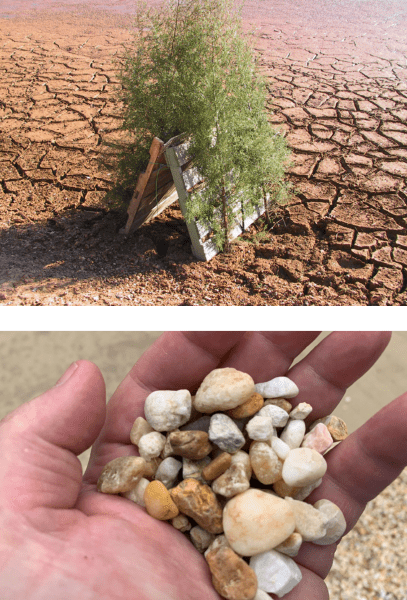
Pallet fish attractor (top picture) and sea gravel (bottom picture).
Fish shelters or “attractors” can be made from many different materials. The purpose of a fish shelter is to provide a place for some small fish to escape predation and attract fish for anglers. These structures should be at a depth of 2 to 6 feet.
Discarded Christmas trees and cedar trees can be good attractors if anchored to the bottom; however, these trees tend to break down quickly and can entangle lures and fishing lines. Other good attractors include stake beds (stakes driven into the bottom), rock piles, construction debris, commercially produced attractors, and trees cut and dropped in from the edge. Usually, only one reef is placed for every 1 to 3 acres, and no more than three per acre are recommended.
Supplemental feeding of commercial fish feeds increases bream and catfish growth. Bass do not readily consume artificial feeds but may benefit from the increase in bream reproduction. Feeding can increase the average size of harvestable fish and total pond production (up to 600+ pounds per acre).
Fish can be fed three to four times a day throughout the warm months of the year. Feed fewer times initially in the spring and increase as the water warms.
To help train the fish to come to the feeding station, feed in the same area and at about the same time of day. Floating feeding rings for containing the feed can be made from PVC tubing anchored in place. Provide up to one feeding station for each 3 acres of pond. Feeding can be done by hand or with automatic feeders.
The protein level of the feed is not very important. Studies have shown that low protein floating catfish feed (25 to 32 percent) enhances growth and attracts bluegill and catfish to the feeder. When feeding with commercial catfish feed, it is important to provide a mixture of larger grow-out feed with smaller pellets (fingerling food) for the bluegill, which have a much smaller mouth than catfish.
Feeds that are specifically formulated for pond bream often contain multiple sizes of pellets for better digestion. These specialized feeds are excellent but are significantly more expensive than commercial catfish feed and are not important to use unless maximizing trophy bream is the goal.
No matter what the formulation of feed, it is critical that the feed be relatively fresh (within 3 months of manufacture) and not moldy. Old feed will have lost much of its vitamin content, and moldy feed can be toxic to fish and to humans if the dust is breathed in.
It is very important not to overfeed. Provide all the feed that the fish will eat within 10 to 15 minutes, but not more than 10 pounds per acre per day. Winter feeding is not necessary but may promote marginal increased bluegill growth. In winter, sinking pellets at a rate not to exceed 1 pound per acre per day may be fed.
Feeding is expensive, but it attracts fish, making them easier to catch. Watching the fish feed can be entertaining, and at least a portion of the population should show increased growth.
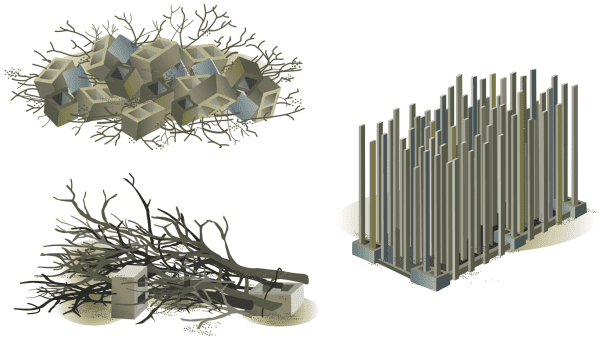
Reefs used as fish attractors.
Overall fertilization, if done correctly, is more effective and economical as a general enhancement of fish productivity. Feeding stimulates plankton blooms similar to fertilization, thus fertilization may be unnecessary if feeding is performed on a regular basis. Always measure water clarity using a Secchi disc when feeding or fertilizing so that too many nutrients are not added to the pond. Feeding also may reduce the effectiveness of grass carp as a weed control as they may prefer to eat pellets rather than weeds.
Clams, snails, or other invertebrates should not be added to ponds to provide food for bluegill and redear sunfish. Additions of the Asiatic clam Corbicula fluminea have caused significant management problems in ponds and also have increased the spread of this invasive species.
Thermal layering (stratification) can be stopped by bubbler-type aerators, underwater fans, and propeller aspirator-type aerators. Destratification eliminates the chance of a fish kill caused by a turnover and increases the area of the pond inhabited by the fish during the summer months.
For additional information on aeration and destratification devices, contact your county Extension agent or fisheries specialist.
Fish also can be encouraged to spawn in areas that are easy to fish by providing a good spawning substrate. Place sand and gravel beds in several locations around the shoreline in 2 to 6 feet of water. The sand and gravel should be 4 to 6 inches deep and can be contained in a frame or box if the bottom is particularly silty.
Bass and bream successfully spawn on many types of substrate, but gravel is highly attractive to these fish. These beds particularly draw bream into specific areas and concentrate spawning where angling over the beds will be convenient.
Read more excerpts from Management of Recreational Fish Ponds at www.aces.edu.
 Rusty Wright, Extension Specialist, Associate Professor, Fisheries, Aquaculture, and Aquatic Services, Auburn University
Rusty Wright, Extension Specialist, Associate Professor, Fisheries, Aquaculture, and Aquatic Services, Auburn University
Revised May 2022, Management of Recreational Fish Ponds, ANR-0577

